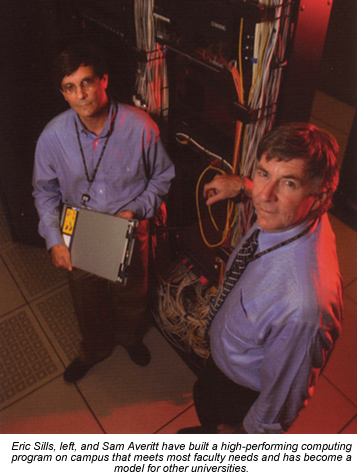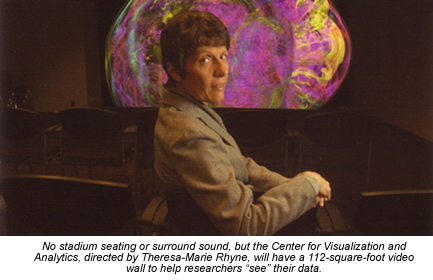CSC News
Computational Science Services – University Helps Researchers Crunch Numbers
When the NC Supercomputing Center (NCSC) ceased operations in June 2003 because of tight finances, it could have added up to trouble for NC State. University researchers accounted for about half of the computing time on the high-powered NCSC machines in Research Triangle Park, and administrators had to devise a system quickly to replace the lost supercomputing resources and calm anxious faculty.
Three years later, NC State's High-Performance Computing Program (HPC), created from a crisis, is a cost-effective model in higher education, and faculty members are doing more advanced computer work than ever. The University has also launched centers to encourage interdisciplinary collaboration in computational science and to transform the complex data generated by simulations into images.
 Administrators quickly decided after NCSC closed that NC State couldn't get into the supercomputing game. The simple reason: money. "You're out on the bleeding edge of technology, and no institution can reasonably maintain a system like that without major federal or other support," Vice Provost for Information Technology Sam Averitt says. Instead, a strategy to take care of the advanced computing needs of most professors was mapped out, and those who really needed supercomputing time could seek it from specialized national labs. "The tendency is for everybody to call everything supercomputing, but there’s a real dividing line between it and high-performance computing,” Averitt says. High-performance computing requires more power than a personal computer but still can be run on standard hardware and software, while supercomputing needs special machines and code to run simulations with millions of calculations. By establishing the HPC, Averitt says, NC State addressed about 80 percent of the advanced computing gap created by NCSC's demise.
Administrators quickly decided after NCSC closed that NC State couldn't get into the supercomputing game. The simple reason: money. "You're out on the bleeding edge of technology, and no institution can reasonably maintain a system like that without major federal or other support," Vice Provost for Information Technology Sam Averitt says. Instead, a strategy to take care of the advanced computing needs of most professors was mapped out, and those who really needed supercomputing time could seek it from specialized national labs. "The tendency is for everybody to call everything supercomputing, but there’s a real dividing line between it and high-performance computing,” Averitt says. High-performance computing requires more power than a personal computer but still can be run on standard hardware and software, while supercomputing needs special machines and code to run simulations with millions of calculations. By establishing the HPC, Averitt says, NC State addressed about 80 percent of the advanced computing gap created by NCSC's demise.With 500 processors in a cluster of machines, the HPC runs nonstop year round. Every faculty member is allotted time on the machines for projects requiring the power of eight to 100 processors. But the more time you use, says Eric Sills, a former NCSC manager who now oversees high-performance computing for NC State's Information Technology Division, the farther down in the queue your name drops to await your next turn. Also, getting on the machines is sometimes like booking a restaurant reservation. "A job requiring fewer than 32 processors can get done pretty fast," Sills says. "But scheduling something larger is like waiting for a table for six to open up."
NC State also created a system that gives preference to faculty members who use grant money to purchase computers that complement HPC equipment. The center maintains the computers, and when the professors aren't using the machines, more projects can be run for others. "Processor cycles are money," Averitt says. "Professors might not view giving us their unused cycles as a payment for our services, but it does have a tangible value." The partner program provides enough equipment to account for about a third of HPC's $1.2 million annual budget, and other universities have begun to copy the arrangement.
Professors needing more computational firepower than the HPC can provide often turn to Oak Ridge National Laboratory (ORNL). The Department of Energy (DOE) lab houses one of the most powerful supercomputers in the world, and the staff there helped guide NC State in developing the HPC to meet less-intensive computing needs. NC State is one of eight universities that oversee ORNL, and the bonds between Raleigh and the Tennessee lab include sharing five faculty members with joint appointments. "Having close connections to staff at DOE labs gives you a leg up in competing for time and equipment," says Ray Fornes, associate dean for research in the College of Physical and Mathematical Sciences (PAMS) and the liaison between NC State and ORNL. But he says the importance of the relationship with ORNL goes beyond sharing faculty and access to supercomputers. "Research is key to our economic future, both as a state and a region," he says, "so research enterprises like this must be nurtured if we are to compete successfully."
Because competition for supercomputer access at ORNL and other facilities is stiff, professors must do preliminary work on campus so as not to waste time on the high-powered machines. The three-year-old Center for High-Performance Simulation (CHiPS) on Centennial Campus provides a computer cluster with close to 100 processors to help professors debug and optimize their computer code. "We have a very powerful group of supercomputing experts at NC State, which has given us a fairly bold reputation nationally," says Keith Gubbins, the Clark Distinguished University Professor of Chemical Engineering who directs CHiPS together with Drexel Professor of Physics Jerry Bernholc. The 27 PAMS and College of Engineering faculty members involved with the center landed $8.2 million in research grants last year. But the primary thrust of CHiPS is to hold seminars and bring in visiting scientists so researchers from different fields who are involved in computational science have a chance to work together and advance the field of computational science, Gubbins says. "The trend in science is toward interdisciplinary teams," he says. "So we try to encourage collaboration."
 While CHIPS helps researchers prepare for their simulations, the Visualization Facility, sponsored with the Renaissance Computing Institute at NCSU, the University of North Carolina at Chapel Hill, and Duke University, bolsters the other end of the process—analyzing the data generated by simulations. "Data visualization is basically matrices and geometry," center director Theresa-Marie Rhyne says. "We provide eye candy for researchers." Using various software programs, the center transforms the numbers into 3-D images and allows professors to rotate, zoom in, and move though each image to examine it from different angles. Soon, those images will be projected onto a bank of 16 screens filling an eight-foot-high, 14-foot-wide wall in a new Centennial Campus office, providing the detail needed for in-depth analysis. "Computational research is becoming more widespread and more complex," Rhyne says. "NC State is trying to provide the resources researchers need to be successful."
While CHIPS helps researchers prepare for their simulations, the Visualization Facility, sponsored with the Renaissance Computing Institute at NCSU, the University of North Carolina at Chapel Hill, and Duke University, bolsters the other end of the process—analyzing the data generated by simulations. "Data visualization is basically matrices and geometry," center director Theresa-Marie Rhyne says. "We provide eye candy for researchers." Using various software programs, the center transforms the numbers into 3-D images and allows professors to rotate, zoom in, and move though each image to examine it from different angles. Soon, those images will be projected onto a bank of 16 screens filling an eight-foot-high, 14-foot-wide wall in a new Centennial Campus office, providing the detail needed for in-depth analysis. "Computational research is becoming more widespread and more complex," Rhyne says. "NC State is trying to provide the resources researchers need to be successful." Published with permission, from the Fall 2006 issue of RESULTS magazine.
Photos by Roger Winstead.
Return To News Homepage